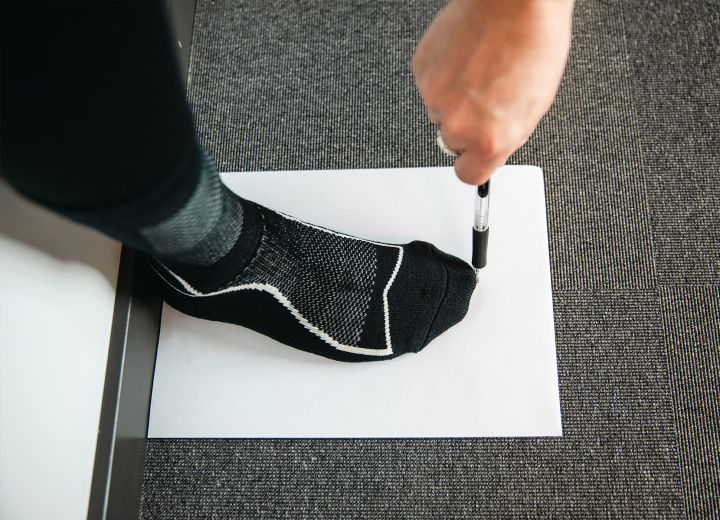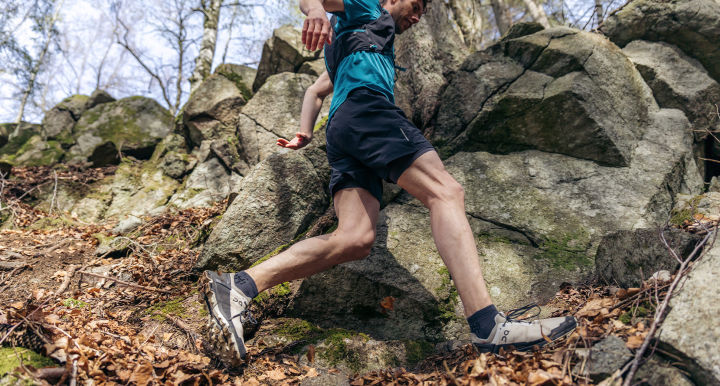
Choosing the right shoe size
It's important that shoes fit comfortably when you're out on adventures or playing sports as well as everyday – that's why we at Outnorth have tried to make it easy to find your size. But it's not enough for the shoes to fit and sit comfortably, different activities may require different sizes for you to perform at your best. In this guide, we explain our size guides, widths and the size recommendations for shoes for different activities.
How do I measure my foot?
To best measure your foot, we recommend that you stand barefoot or with a thin sock on a piece of paper that you place on the floor with the short side against a wall. Place your foot with the heel against the wall and either draw a line on the paper at your longest toe or draw around your entire foot with the pencil held as vertically as possible. Then measure from the edge of the paper that was against the wall to the line you drew at your longest toe, making sure the paper is flat on a flat surface – this is your foot measurement.
At Outnorth, we have ensured that most of the measurements we write in the size charts are the inside measurements of the shoe, this means that you should add a few centimeters to your measured foot length to find your optimal shoe size. The measurement we recommend you add varies depending on the type of shoe you buy and is always written in the size chart. For example, if you are going to buy a hiking boot, we recommend that you add 1.5–2 cm to your foot measurement to have enough room for thick socks or multiple socks in your boots. So if your foot is 27 cm long, you should have the size with an insole measurement around 28.5–29 cm in the hiking boot. If you are between two sizes, it is usually better to choose the larger size. In the next paragraph, we explain how much bigger we recommend your shoe be than your foot, and why.

How to measure your foot
How should the shoes fit?
Shoes can make or break your next adventure – a pair of comfortable shoes will get you where you want to go and a little further, while a pair of shoes that are too small or too big can chafe and hurt. At Outnorth, we have several years of experience with comfortable shoes, therefore we can recommend our customers to make good shoe purchases that will work for the activity you want to do. Reading and reviewing the size chart leads to better purchases and prevents unnecessary returns – good for both you and nature!
Hiking shoes
When you're hiking, comfortable shoes are essential, you want to keep your feet dry and warm in order to enjoy the beautiful nature. Therefore, it is often recommended that you wear several pairs of comfortable socks when hiking. Two pairs of socks protect your feet from chafing and keep you warm. For this reason, at Outnorth we recommend that you choose a shoe with an inner measurement that is 1.5–2 cm larger than your foot. In this way, you ensure that you can fit several pairs or extra thick socks without the shoes feeling cramped. If you want to read more about recommended socks during various activities, you can take a look at our Sock guide.
Running shoes
When you run, your feet often take center stage – having a nice pair of running shoes on your feet will make you fly forward so you can perform at your peak. Running shoes should not fit loosely, but even worse is when they are too small. At Outnorth we recommend that your running shoes are 1–1.5 cm larger than your foot, then you can tie the shoes well to get a perfect fit around the foot, but still have room to wiggle your toes.
Running Shoes
Fit
Shaft height
Shoes have different shaft heights that benefit you depending on the activity you intend to use the shoes for. Shaft height means the height of the shaft of the shoe, the part that goes up the leg from the foot. A low shaft height is often recommended when running to give your ankle freedom of movement. A medium-high shaft can provide support for the leg and is good when you are hiking, for example. A high shaft provides even more support for the ankle and protects your legs from twigs, snow and wetness – which is also good when you're hiking. A lower shaft is therefore preferable during intensive activities, while a higher shaft can provide support and protection out in nature and above all on uneven terrain.
Last width
If shoes feel tight or large across the foot, you may need a different last width – this is the width of the insole of the shoe. At Outnorth, we divide shoes into normal, wide, narrow and hallux valgus last width. Below we explain the difference between these.
A normal last width fits most people, it is designed according to the average foot width. If your shoes fit well in the toes but feel tight across the foot, you can try a shoe with a wide last – this gives the foot more room in the shoe for a comfortable fit for you with a wide foot. If shoes often fit loosely around the foot, you can instead try a shoe with a narrow last. Narrow shoes are for those with a narrow foot to provide a comfortable and tight fit. Hallux valgus can result in your toe joint sticking out, shoes with a hallux valgus adapted last provide space for this instead of squeezing and being tight. Wide last can also work for those with hallux valgus.

